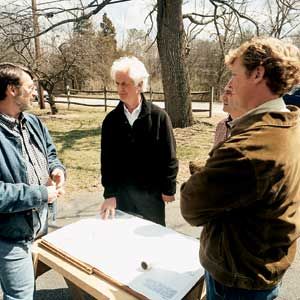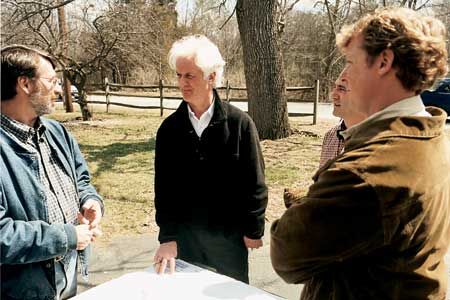
About the only predictable thing about a remodeling project is that at some point the unpredictable will happen. Demolition reveals an unusual or nonstandard construction practice from long ago; a subcontractor or product isn’t available when scheduled; or old drawings and documents don’t quite match actual conditions on the site. As anyone who’s ever remodeled can attest, flexibility and patience are key when developing solutions for unanticipated problems.
Our first Carlisle surprise was a septic tank that turned out to be unexpectedly close to the foundation we were digging for the extension behind the old house. Actually, it was in the new foundation. Our choices were to rethink the extension or move the tank. Since reducing the size of the master bedroom by nearly half was out of the question, the only solution was to relocate the tank — which in turn meant new engineering drawings, permission from the local building and health departments, and the not-so-minor chore of repositioning a 2,000-gallon tank.
Septic systems are essentially pretty simple (“glorified composters,” as our plumbing guru Richard Trethewey calls them). Wastewater—from sinks, toilets, washers, and every other drain in the house—runs downhill to a large holding tank buried outside. Gravity separates the contents of the tank into solids, which settle to the bottom; soap and other scum, which rise to the top; and a liquid layer, which stays in the middle. The liquid layer is fed by water coming in from the house as well as by decomposing solids rising from the bottom of the tank. Liquid exits the tank and drains to a distribution box or two, where it’s diverted into several tubes that stretch out into an underground leach field. Liquid seeps out from the tubes and percolates downward, where naturally occurring bacteria in the soil break down waste products and render them harmless before they reach groundwater below.
Because it’s so important to keep wastewater separate from fresh water, building and health codes are rigorous about where tanks, drainage boxes, and leach fields can be located. In Carlisle, the tank must be at least 10 feet from any foundation wall and at least 100 feet from any well. On a relatively small property like this one, those requirements often leave an engineer with limited choices on where the system components can be located. Our engineer proposed a new site for the tank roughly behind the barn, closer to the existing leach field and far enough away from the nearest well to meet code. That means removing the old tank and one of the old distribution boxes, and running a new pipe connecting the new tank to a second distribution box, where liquid will drain to the existing leach field
Theoretically, of course, we could have just moved the old tank to its new location. But with the amount of digging and building we’re doing, it makes a lot more sense to install a brand-new one. “Given that these tanks have a certain life expectancy, and we have no way of knowing how old the existing tank is, we might as well install a new one,” says Richard. “It’s smarter in the long run — we don’t want to get the building done and then have the tank fail. We have all the equipment there, and we’re digging up the yard anyway, so it makes sense to put in a new one.”
Our relocation plan got the thumbs-up from the health department on June 5, so we were able to restart the foundation excavation that we’d had to suspend when we found the tank. We’ll actually install the new tank later in the summer; our top priority now is to finish excavating and get the new foundation in. That means pouring the footings for the concrete block that will tie the old foundation to the new one, then getting the town to sign off on those footings before we install the foundation walls (see Foundation on a Flatbed).
Since we’re always on the lookout for ways to demonstrate how house systems work, we’ll include a “Septic Systems 101” segment of one of our episodes (watch for it this fall when the Carlisle Project debuts on PBS). The installation and repiping will mean a bit more digging in the backyard than we’d expected, and it may mean sacrificing a tree that we’d rather keep — but that’s what the unexpected is all about.
For more information, see the EPA Web site on Principles of Septic Systems.

